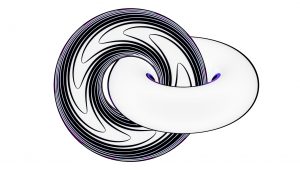AMR Colloquium
Henri Poincare
University of Paris
The Smooth 4-dimensional Me Conjecture
July 4, 2022 6PM UTC (GMT)
11 AM Los Angeles, 2 PM New York, 6 PM London, 7 PM Paris, 8 PM Kyiv, 11 PM Moscow, 2 AM Singapore, 5 AM Melbourne

This colloquium will cover recent developments in the Poincare Conjecture. The format will be three 15 minute segments, with questions by a panel following each segment. Below you can find resources related to this topic. An introductory background lecture by Bernhard Riemann, “Background for understanding the 4D-Poincare Conjecture” is available, as are other resources.
An introductory lecture by Bernhard Riemann explains the background, history, and the context of the colloquium talk.

The Poincare Conjecture dates back to 1905 when Poincare asked if a 3-dimensional manifold with trivial homology groups was homeomorphic to a 3-sphere. He himself realized a restatement was needed, as the Poincare homology sphere gives a contradiction to the original statement. … 

Suggested background reading to follow the ideas of the lecture.
 Online videos related to the lecture.
Online videos related to the lecture.
A variety of approaches to the conjecture.

Some open problems connected to the Poincare Conjecture 
How this solution affects topology. What are the likely directions going forward.
Questions submitted to the speaker after the lecture and responses by the speaker.
Question: Why is dimension four different from dimension 5, or 50?
Answer: A key step in the process is to slide around curves that give instructions on how to build a manifold. These curves trace out 2-dimensional surfaces as they move. Pairs of such surfaces are disjoint in dimensions above 4, but can have irremovable intersections in dimension 4 and below. Thus things change drastically when moving from dimension 4 to dimension 5. For more details see [references].
Colloquia Series Working Group
Craig EVANS, UC Berkeley
Henri DARMON, McGill University
Susan FRIEDLANDER, University of Southern California (Chair)
Mark GORESKY, Institute for Advanced Study
Eva MIRANDA, Universitat Politècnica de Catalunya and Centre de Recerca Matemática in Barcelona
(Affiliations for identification purposes only)
